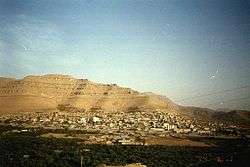
Derik, Turkey
Derik (Syriac: ܖܪܝܟܐ Dêrike, Kurdish: Dêrika Çiyayê Mazî) is a district of the Mardin Province in the southeastern Anatolia region of Turkey. It has borders with Mazıdağı, Viranşehir and Kızıltepe.
History
The town is first mentioned in the late 14th century, however a Roman fort indicates that the area has been inhabited for longer. Prior to the Assyrian and Armenian genocide, Syriacs and Armenians formed the majority in the district. The Armenian population of the county continued to form the majority even up until the 1930s, when systematic state persecution forced many to emigrate. One family continues to live here, and they maintain the old Armenian Church. The Armenian church here is the only one in the province that is active, and one of only 7 in Anatolian Turkey that operates as a church.
Geography
Geographically the town includes areas from Mazıdağı foot descending towards Ceylanpınar plains. Town area descends from the north to the south. The city center is surrounded by mountains from 3 sides and has a temperate climate with some mediterranean climate effects.

.sic
The name sic is a proposed top-level domain for the Domain Name System of the Internet. It is as an abbreviation of Siculitas (Székely), a historic region in Transylvania, and was requested in 2009 by an initiative of the Szekler National Council for presenting Szeklerland on the Internet.
The application was accepted by ICANN on May 13, 2009.
SIC
Sic, as the label "[sic]" found immediately following a copy of text, indicates that the source is presumed to be erroneous and has been intentionally transcribed without correction.
Sic, SIC, etc. also may refer to:
Sic:
sic:
As an acronym, SIC may refer to:
Arts and media
Organizations
Sports

Sic (album)
[Sic] is a jazz/fusion album released in 2005 by Austrian guitarist Alex Machacek. The album features drummer Terry Bozzio.
Track listing
All tracks composed by Alex Machacek.
Personnel
References

Lane
In the context of traffic control, a lane is part of a carriageway (roadway) that is designated for use by a single line of vehicles, to control and guide drivers and reduce traffic conflicts. Most public roads (highways) have at least two lanes, one for traffic in each direction, separated by lane markings. On multilane roadways and busier two-lane roads, lanes are designated with road surface markings. Major highways often have two multi-lane roadways separated by a median.
Some roads and bridges that carry very low volumes of traffic are less than 15 feet (4.6 m) wide, and are only a single lane wide. Vehicles travelling in opposite directions must slow or stop to pass each other. In rural areas, these are often called country lanes. In urban areas, alleys are often only one lane wide. Urban and suburban one lane roads are often designated for one-way traffic.
Capacity
Lane capacity varies widely due to conditions such as neighbouring lanes, lane width, elements next to the road, number of driveways, presence of parking, speed limits, number of heavy vehicles and so on - the range can be as low as 1000 passenger cars / hour to as high as 4800 passenger cars /hour but mostly falls between 1500 to 2400 passenger cars / hour.
Lane (disambiguation)
A vehicle lane is a part of a road designated for use by a single line of traffic.
Lane may also refer to:
Roads
Places
People
Surname
Given name
Fiction
Lane (surname)
Lane is a surname with two separate origins in Britain and Ireland.
Meanings and origins
Lane is also an Anglicized form, of three Irish Gaelic surnames.
A
B
Podcasts:

